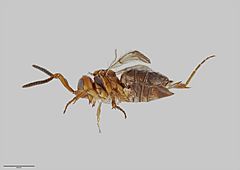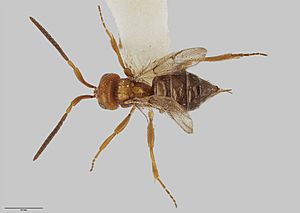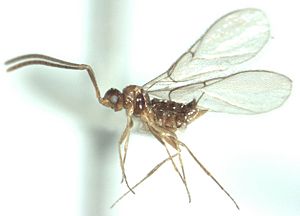Maaminga facts for kids
Quick facts for kids Maaminga |
|
|---|---|
 |
|
| Maaminga marrisi lateral view | |
 |
|
| Maaminga marrisi dorsal view | |
| Scientific classification | |
| Kingdom: | |
| Phylum: | |
| Class: | |
| Order: | |
| Suborder: | |
| Superfamily: |
Diaprioidea
|
| Family: |
Maamingidae
Early, Manser, Naumann, & Austin, 2001
|
| Genus: |
Maaminga
|
| Species | |
|
|
Maaminga is a special group, or genus, of tiny wasps. These wasps are known as parasitic wasps. This means they lay their eggs on or inside other insects. There are two known species in this group, and they make up their own unique family called Maamingidae.
These fascinating wasps have only ever been found in New Zealand. The two species are named Maaminga marrisi and M. rangi. The name Maaminga comes from the Māori word "māminga." This word means "trickster." They got this name because they were very good at hiding. Scientists had a hard time finding them for a long time!
Contents
Discovering Maaminga Wasps
Scientists first described the Maaminga wasps in 2001. Before that, they were unknown to science. Their small size and hidden habitats made them tricky to spot. Finding them helped us learn more about the amazing insects of New Zealand.
The Two Maaminga Species
The two species of Maaminga wasps are quite different. Each one prefers different places to live.
Maaminga rangi: The Forest Dweller
Maaminga rangi is a delicate and slender wasp. It is quite common in forests, especially in the northern parts of New Zealand's North Island. You can often find it in kauri forests. Kauri trees are very tall and old trees native to New Zealand.
Maaminga marrisi: The Tough Explorer
Maaminga marrisi is a bit different. It is more robust and stocky. This species can also have different wing sizes. Some M. marrisi wasps have full wings, while others have shorter wings. This helps them adapt to different environments.
M. marrisi is often found near the coast. It lives in coastal scrub and forests, especially on islands off the main coast. But it's also tough enough to live in cold, high places. You can even find it in alpine snow tussock areas. These are places with tall, tough grasses in the mountains.
Maaminga's Place in the Insect World
Scientists group living things into families and orders. This helps us understand how they are related. The Maaminga family (Maamingidae) belongs to a larger group of insects called Hymenoptera. This group includes wasps, bees, and ants.
Originally, Maamingidae was placed in a group called Proctotrupoidea. However, after more study, scientists moved them. Now, they are part of the superfamily Diaprioidea. This group also includes other wasp families like Diapriidae and Monomachidae. This change shows how scientists learn more over time. They keep updating the "family tree" of life on Earth.


